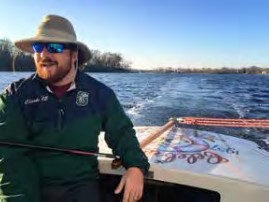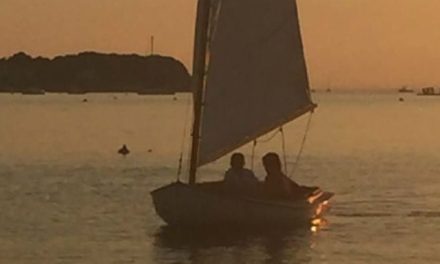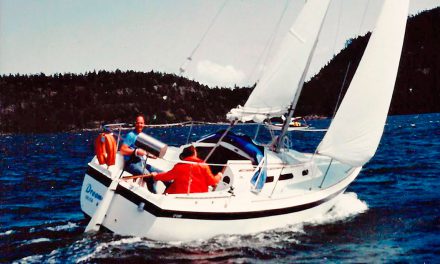 A rally cruise for small sailboats could become habit-forming
A rally cruise for small sailboats could become habit-forming
The best way to start any voyage is by seeking advice, in my case from an old high school friend who was once a professional sailor. Richard immediately affirmed that competing in the Texas 200 would be a great adventure and that Anoesis II, my 17-foot Harpoon 5.2 (he’d once sold them), would be a great boat in which to do it. He then recommended I read everything by and about Shackleton, to prepare myself mentally.
That wasn’t exactly where I had been going in my mind, so I latched on to his affirmations and went to the Texas 200 Sailing Club Facebook page and website (Texas200.com) to seek further advice.
The Texas 200 is an annual gathering of small boats that travel more or less in company through the Laguna Madre and the bays of South Texas for five or six days and 200 miles. The videos and pictures on its website were encouraging. I saw interesting wooden boats with colorful sails, smiling sailors, porpoises at play, pelicans and gulls, and leaping fish. The advice about preparation was a little more sobering, albeit not quite Shackletonian as there was neither freezing nor starvation involved. But there were plenty of stories of overturned boats losing all their gear, people helicoptered out after lacerating their feet and hands on oyster shells, sunburn requiring hospitalization, equipment failures of all sorts, man-eating mud flats, howling gales, and days of “bob and bake” doldrums. That’s the Texas 200. But participants in this carnage sign up to do it again, so I was ready to go.
Committed, my first step was to make major upgrades to my boat. I added a complete electrical system with a panel controlling a cuddy-cabin light, running lights, an anchor light, and charging stations for an iPhone, an iPad, and a VHF radio. To power it all, I bought the largest standard marine battery I could fit, mounted it forward for trim, and installed solar panels aft to recharge it.
While advice from down on the coast was encouraging, back in Dallas, my fellow freshwater sailors were skeptical to the point of giving me a fair amount of grief concerning these upgrades. Many questioned the utility of running lights a mere 12 inches above the water, or an anchor light when beaching the boat was the goal. They weren’t convinced that while having a full set of running lights might be quixotic, safety demanded that if I did have to sail at night, I at least be visible to the barge that runs me down. And I did give up on plans for a refrigerator and portable AC, showing what seemed like genuine restraint, although in fact, given the small footprint of the boat, I simply couldn’t mount enough solar panels to power them.

The wind at the Texas 200 can blow hard or not at all, as here, when the fleet was ghosting into the Laguna Madre.
A rosy vision
By May, I’d assembled basic camping equipment, a simple bed of cedar planks laid crosswise just behind the cuddy cabin, 20 gallons of water, and way too much food. With two ice chests using a combination of dry ice, regular ice, and a frozen mixture of water and alcohol I read about in Good Old Boat (see “Ice Magic,” May 2014, and “Beating the Heat,” May 2016), I felt prepared. My plan was that each day, after a hard six to eight hours of sailing, I would drop anchor and either read a book in the shade of my specially mounted beach umbrella or, if conditions allowed, go ashore and set up camp. As the sun set, I’d fire up the Coleman stove, cook a decent meal, have a beer or two, and be rocked to sleep by the gentle waves. Come morning, I’d enjoy an early break- fast of tacos, sip a cup of coffee (from the camp-stove espresso maker), weigh anchor, and sail to the next campsite. Living the dream, my friends.
With this vision in mind, I arrived in Port Mansfield, essentially a built-up fish camp, its familiarity with sailboats indicated by the number of live electrical wires that surround the only boat ramp. That is, they were live until a Texas 200 participant backed his Hobie Cat’s already stepped mast into them, depriving half the town of electricity for a few hours. Not that this evinced much of a panic among the locals, who bear the strong fatalism of those who make their livelihood on fishing for redfish and trout and spend three months a year tracking hurricanes.

On day one, Robert and Anoesis II had plenty of wind to ensure rapid progress northward.
By the time of this incident, my asking around the bait shop for the whereabouts of the harbormaster had led me to the mayor, a ruddy gentleman lounging in a lawn chair, beer in hand and wearing shorts, flip-flops, and an old Metallica T-shirt.
“I’m not sure what slip I’m supposed to be in.”
The mayor pulled out a cell phone and made a quick call, which brought his wife, the only other town employee, to direct me to my berth.
The next day, about 100 of us gathered in a parking lot and met the organizers, one of whom stood on a pickup truck and handed out information packets and burgees. We were reminded that everyone was on his or her own, there was no support of any kind, to keep our VHF radios on 16, reef early and often, and “don’t think anyone will wait up for you.” Then we caravanned the 200 miles up the coast to Port Lavaca, where we left cars and trailers in the lot of a friendly eat-and- get-gas place, and were bused back to Port Mansfield.

Robert usually daysails his Harpoon 5.2 on a lake, so he had to make some modifications before taking on the Texas 200. They included building a platform for his bed
Reality
Day one dawned still as death. I cast off early and under full sail was barely able to ghost out into the Laguna Madre. Yet I passed a few fellow sailors, and as the wind began to whisper, I felt pretty good as I turned north. It was looking like an easy day. And then the wind picked up. And picked up more. And more. At 12 knots, I lowered the jib and stowed it under bungee cords stretched across the foredeck. At 18 knots, I decided on a reef, which is easier said than done singlehanded. Fortunately, l had a lot of space to do 360s until I finally wrestled in and tied down a reef in the main.

and installing an electrical system for navigation lights and chargers for digital devices
Which is when the wind calmed. I could see the fleet to the west passing me by as they headed to the entrance to the Intracoastal Waterway. I shook out the reef, and in 45 minutes regretted it. Anoesis II was under control, but I seemed to be headed on a beam reach at breakneck speed for a narrow channel in which merely being under control might not be good enough. Once again, I was busier than a one-armed fiddler while I tied the reef back in. I didn’t take it out for the next five days, and sailed one day with just the jib.The wind was often near 20 knots, and rarely below 15, and most of the time I was fully focused on staying upright and in deep water.
The fleet was enormously colorful in terms of boats. Maybe half were production boats like mine. Most looked a bit rode hard and put up wet. I later learned that many were bought nearly derelict just for this event. Two guys were sailing a 17-foot MC Scow and one a Flying Scot with a homemade mizzen strapped to the transom. The rest were homemade wooden boats, colorful of hull and sail and favoring two-sail gaff rigs.
I couldn’t tell much about the people. All of us were wrapped from head to foot against the sun, and in many cases all we could see was each other’s eyes. Indeed, at camp on the third day, a figure stood up on a freshly beached boat and pulled off various wraps. An older gentleman standing next to me gasped and said, “My God, it‘s a girl!” Indeed.

Dressed against the baking Texas sun, Robert is barely recognizable
Although, over 40 miles, routing choices and differences in departure time and speed spread us out, we would see more of each other, at least enough to determine gender, but that involved getting to shore. The designated camp locations were, with one grassy exception, strips of oyster-shell beach backed by scrub and surrounded by anywhere from 50 feet to 100 yards of desperately shallow water, typically 12 inches or less and always directly upwind. I had a strategy for this.
I had put quick-release cleats on both my keel and rudder. My theory was that I’d get up as much speed as possible on a broad reach as close to the shallows as I could. I’d turn upwind, let the keel kick up and then the rudder. Then I’d go forward and toss out the anchor before I got blown backward. I didn’t realize how badly this could go.
Approaching the first already-crowded anchorage, I executed my maneuver. Except the keel stuck and the rudder kicked up. I did a fast 120-degree turn which released the keel. With the rudder floating uselessly behind the boat, I rapidly accelerated into the fleet, a run being the only option. As I’m not a quitter, I managed to pull the rudder back into place, and tried again. And again. Finally, I managed to get the keel up first, make a little headway before the rudder came up, and throw out the anchor, which I followed into the water.
Half an hour later, I’d dragged the boat up to the shore to join an appreciative audience as other boats tried, and quite often failed, the same maneuver. I was wet from the waist down and didn’t really dry out for five days. I couldn’t go barefoot because walking on oyster shells is no different from walking on razor blades.

Aggies Michael Breaux (l) and Nicholas McLin (r) brought a huge sunshade.
A fraternity of sailors
One of the first impressions I gained was that the Texas 200 has really become a family affair. There were husbands and wives of the old-salt variety, fathers or mothers with their sons and daughters, extended families, even some Sea Scouts. It was a good mix, and there are few sights as energizing as watching kids decamp onto a beach and be kids.
Although that wasn’t easy for some on the edge of adolescence. As the sun set the third day, I heard a fragment of conversation between a father and daughter around a nearby campfire in which he said, “This isn’t about your feelings.” Having a daughter of my own (now grown), I knew where he was coming from. In his defense, they had the only tent built especially to enclose a portable toilet. Everyone else, regardless of sex, had to make do behind the scrub up in the dunes.

the wind defined his use of his umbrella
Another thing I realized is that the wind blew toward the setting sun, so that my beach umbrella would either get blown away or blown apart if I tried to use it for shade. Thus I usually sat behind the umbrella rather than under it, pretending to relax and drink a beer as the wind howled around me. The first day, I lasted almost 20 minutes.
That’s when I discovered a group of guys whose functioning shelter was larger than they needed. They were Aggies (Texas A&M alums), and hence rivals relative to my years at the University of Texas. Any port in a storm, as they say. I brought my chair and an offering of beer and made some new friends. Turns out we’d been in our respective schools’ marching bands, even in some of the same games, albeit on opposite sides. The shared suffering of marching on Thanksgiving Day in freezing rain easily led to discussions of the Texas 200 experience. Did I mention they had rum?
As it turned out, time ashore during the Texas 200 could be as good as time on the water. On the water in big wind I really was on my own for eight hours. With everyone sailing on the edge, and the only motor in sight my defunct electric outboard, there was little we could do for each other apart from shouting encouragement as we passed or were passed. But on land it was different.
The second evening, one boat hadn’t arrived and couldn’t be raised on the VHF. So those of us who had them turned on our masthead lights, in case our fellow sailors might not find the camp. It turned out that the missing sailors, seriously delayed, had decided to pull up and camp before sunset some five or six miles short of the group. We cheered them on as they caught up the next morning, having made an early start and adopted a different way of setting their sails.
Folks shared their food, and even their beer when it came to it. Boats that limped into camp with broken parts, torn sails, and lost provisions found that others had tools and parts and sail tape to share. Advice was freely offered. My Aggie friends counseled staying close to the protection of the windward shore in Corpus Christi Bay. I ignored them, and had an unnecessarily exciting couple of hours skating down waves and into waves, which made me grateful for my self-bailing scuppers and foam-filled hull.
So even though I sailed solo, and we had all been warned that we were on our own, it wasn’t surprising that on the last day, as on the first, I found ready help beaching my boat at Port O’Connor, hitching a ride to my car, and getting my trailer down the ramp to pull my boat out of the water.
Lessons
I discovered on the first day that my electronic charts on the iPad and iPhone weren’t all that useful. The devices were hard to read in the sun, and harder to manage with a hand on the tiller and a hand on the sheet. By the second day, after conferring with the Aggies, I’d reduced my routes to a set of landmarks and bearings, and steered by compass.
Which drove home the importance of the hard-won wisdom on how to locate the shortcut passes between the bays. When experienced sailors say to exactly line up a capped gas well and a deserted shack when approaching a pass, best listen. I touched sand a number of times, and learned that charts can’t compare with local knowledge.
Over the course of the rally, my Harpoon fared well. Some of the stainless steel fixtures needed cleaning, and the tiller extension, not as robustly stainless as I’d thought, had bent and finally broken in my fight against the inevitable weather helm from a reefed mainsail and no jib. And of course, the boat was covered, inside and out, with a scummy film of salt that would take serious work to wash off.
As a freshwater sailor venturing into salt water, I had feared the incursion of rot, but the wooden seats I’d sealed with multiple layers of spar varnish did fine. So did the cedar boards making up my bed. Water had drained out and not through the wooden reinforcement in the hull. Although the clothes I’d worn for five days were trash, dry bags kept my bedding and other clothing dry. The electrical system, mounted high inside the cuddy cabin and waterproofed, was fine.
It wasn’t until two months later, in a routine visit to the dermatologist, that the shoe dropped. As I stood almost completely naked (when will I get back to doing sit-ups?), the doctor gazed down from her heel-enhanced, always fashionably garbed heights. Looking at the soles of my feet and the calluses I attributed to a well-sandaled summer, she disgustedly pronounced, “Foot warts. What have you been doing to your feet?”
When I explained the Texas 200, she shuddered. She suggested I dress, washed her hands a second time, and had the medical assistant swab the floor. Before leaving, she gave me a prescription for a cream to be applied daily and forever. Our encounter reminded me of the refrain of a Bouncing Souls song favored by my son’s punk-rock friends: “I’m a hopeless romantic, you’re just hopeless.”
And that’s when I knew I’ll be sailing the Texas 200 again.




